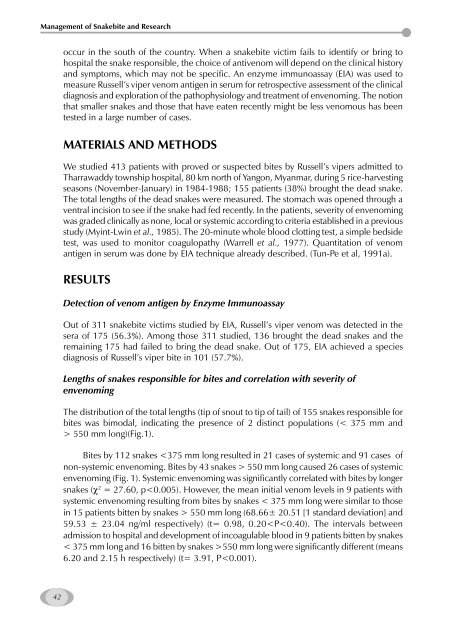Management of Snakebite and Research Management of Snakebite ...
Management of Snakebite and Research Management of Snakebite ...
Management of Snakebite and Research Management of Snakebite ...
Create successful ePaper yourself
Turn your PDF publications into a flip-book with our unique Google optimized e-Paper software.
<strong>Management</strong> <strong>of</strong> <strong>Snakebite</strong> <strong>and</strong> <strong>Research</strong><br />
42<br />
occur in the south <strong>of</strong> the country. When a snakebite victim fails to identify or bring to<br />
hospital the snake responsible, the choice <strong>of</strong> antivenom will depend on the clinical history<br />
<strong>and</strong> symptoms, which may not be specific. An enzyme immunoassay (EIA) was used to<br />
measure Russell’s viper venom antigen in serum for retrospective assessment <strong>of</strong> the clinical<br />
diagnosis <strong>and</strong> exploration <strong>of</strong> the pathophysiology <strong>and</strong> treatment <strong>of</strong> envenoming. The notion<br />
that smaller snakes <strong>and</strong> those that have eaten recently might be less venomous has been<br />
tested in a large number <strong>of</strong> cases.<br />
MATERIALS AND METHODS<br />
We studied 413 patients with proved or suspected bites by Russell’s vipers admitted to<br />
Tharrawaddy township hospital, 80 km north <strong>of</strong> Yangon, Myanmar, during 5 rice-harvesting<br />
seasons (November-January) in 1984-1988; 155 patients (38%) brought the dead snake.<br />
The total lengths <strong>of</strong> the dead snakes were measured. The stomach was opened through a<br />
ventral incision to see if the snake had fed recently. In the patients, severity <strong>of</strong> envenoming<br />
was graded clinically as none, local or systemic according to criteria established in a previous<br />
study (Myint-Lwin et al., 1985). The 20-minute whole blood clotting test, a simple bedside<br />
test, was used to monitor coagulopathy (Warrell et al., 1977). Quantitation <strong>of</strong> venom<br />
antigen in serum was done by EIA technique already described. (Tun-Pe et al, 1991a).<br />
RESULTS<br />
Detection <strong>of</strong> venom antigen by Enzyme Immunoassay<br />
Out <strong>of</strong> 311 snakebite victims studied by EIA, Russell’s viper venom was detected in the<br />
sera <strong>of</strong> 175 (56.3%). Among those 311 studied, 136 brought the dead snakes <strong>and</strong> the<br />
remaining 175 had failed to bring the dead snake. Out <strong>of</strong> 175, EIA achieved a species<br />
diagnosis <strong>of</strong> Russell’s viper bite in 101 (57.7%).<br />
Lengths <strong>of</strong> snakes responsible for bites <strong>and</strong> correlation with severity <strong>of</strong><br />
envenoming<br />
The distribution <strong>of</strong> the total lengths (tip <strong>of</strong> snout to tip <strong>of</strong> tail) <strong>of</strong> 155 snakes responsible for<br />
bites was bimodal, indicating the presence <strong>of</strong> 2 distinct populations (< 375 mm <strong>and</strong><br />
> 550 mm long)(Fig.1).<br />
Bites by 112 snakes 550 mm long caused 26 cases <strong>of</strong> systemic<br />
envenoming (Fig. 1). Systemic envenoming was significantly correlated with bites by longer<br />
snakes (χ 2 = 27.60, p 550 mm long (68.66± 20.51 [1 st<strong>and</strong>ard deviation] <strong>and</strong><br />
59.53 ± 23.04 ng/ml respectively) (t= 0.98, 0.20









